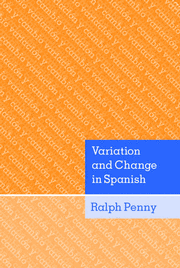Book contents
6 - Variation in Judeo-Spanish
Published online by Cambridge University Press: 05 June 2012
Summary
Judeo-Spanish (in Spanish, judeoespañol) is the name given by many scholars to those varieties of Spanish spoken by descendants of the Jews who were expelled from Spain in 1492. There is no universal name by which these varieties are known to their speakers, although both judezmo and the simple español are used by some of the relevant communities, as is ladino. However, this last term is reserved by some scholars for written varieties of Judeo-Spanish, especially renderings of the Old Testament which closely follow the syntax of the Hebrew while using Spanish morphemes. The term Sephardic Spanish (español sefardí or español sefardita) has the same broad meaning as Judeo-Spanish, but is only used in academic and similar writing.
Before the expulsion from Spain, Jews wrote Spanish using Hebrew characters (on the basis of transliteration of each Latin character into a Hebrew letter), and notable literary and non-literary examples of this writing survive from medieval Spain. This style of writing continued after 1492, in various parts of the Balkan and Mediterranean world, and has provided many surviving examples, but lack of contact with Peninsular Spanish meant that Judeo-Spanish spelling acquired independence from its Peninsular model. Later, in the nineteenth century, there grew up the practice of writing Judeo-Spanish in the Latin alphabet, a system now consisting of correspondences between Latin letters and Judeo-Spanish phonemes, but with spellings based on French orthographical rules.
Information
- Type
- Chapter
- Information
- Variation and Change in Spanish , pp. 174 - 193Publisher: Cambridge University PressPrint publication year: 2000
